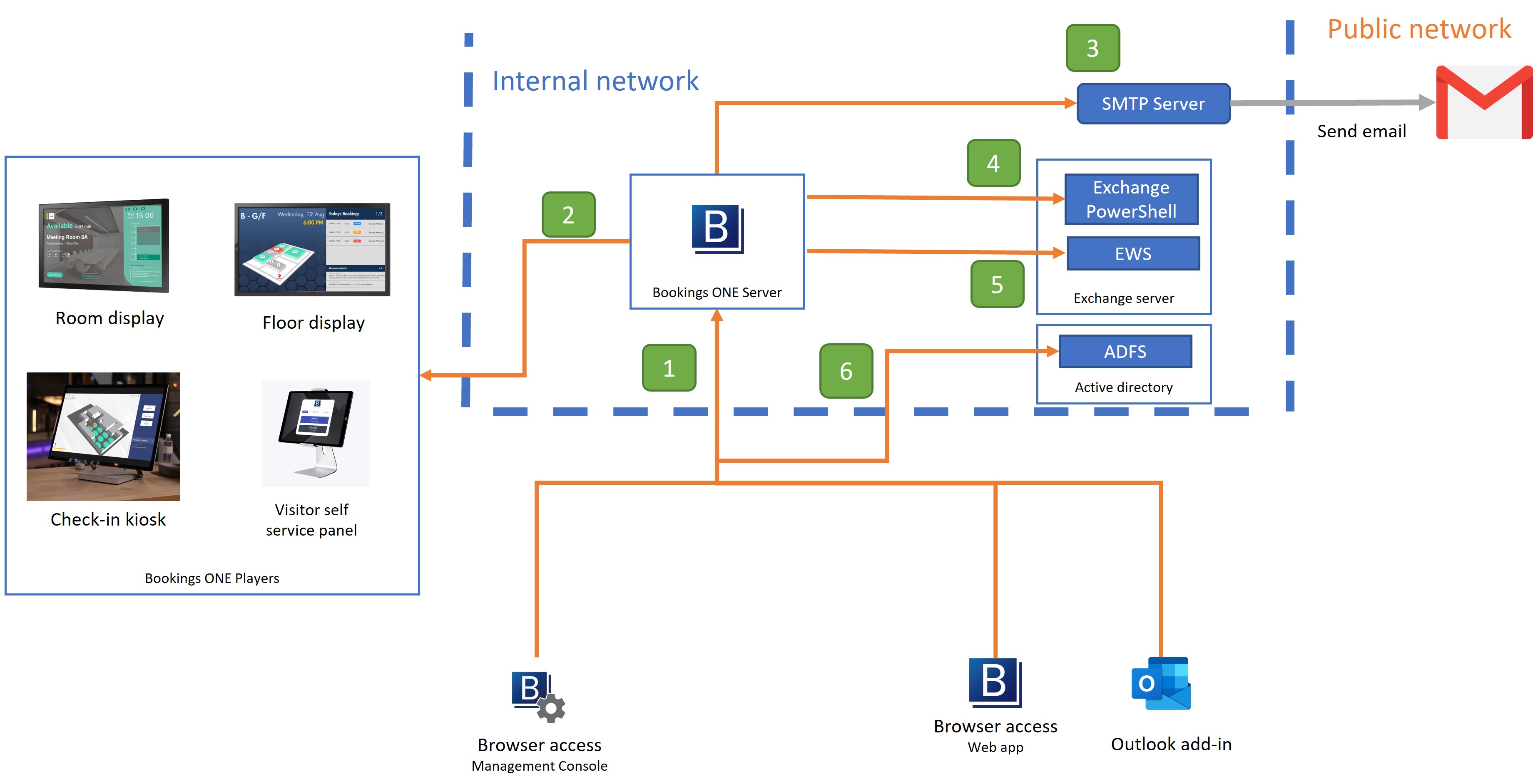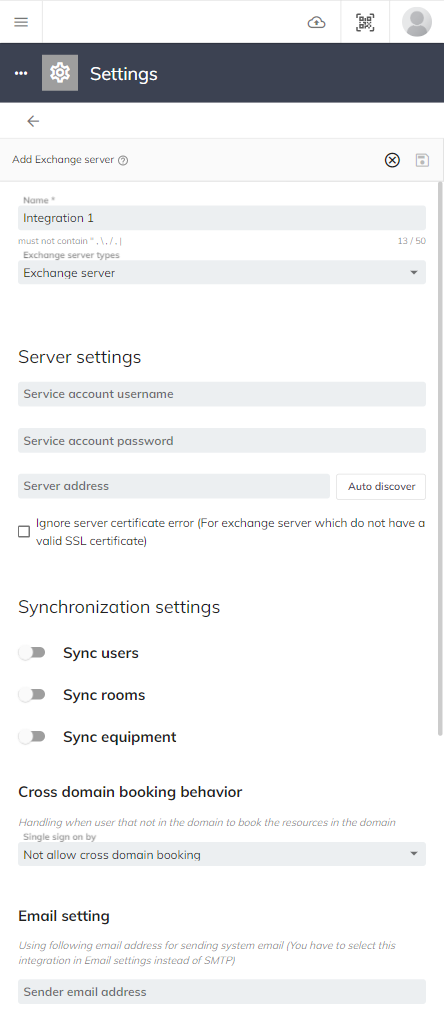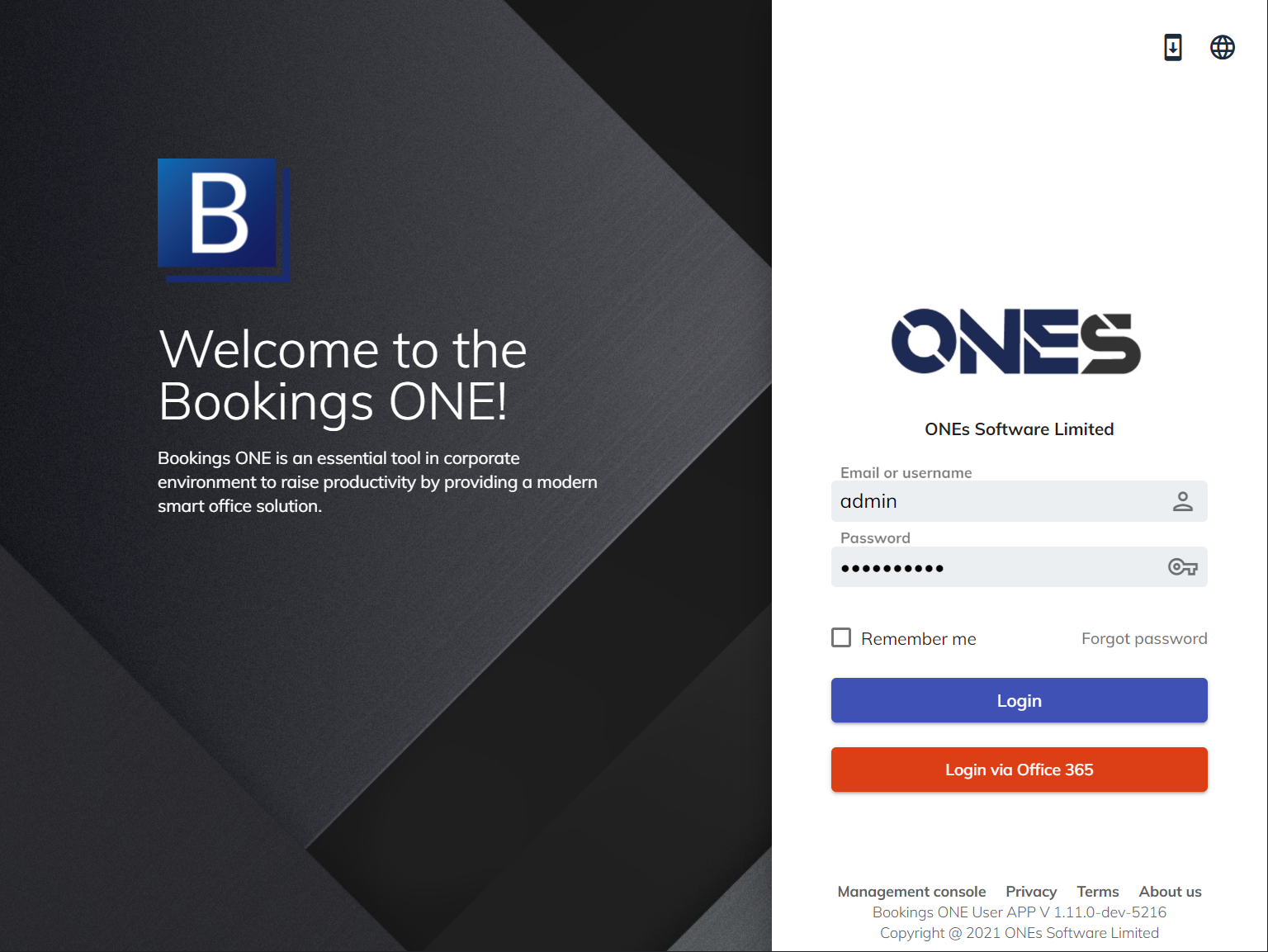Exchange server integration
This section will introduce the procedure of integration with Exchange Server. Based on the following integration steps, user can:
- Synchronize room / equipment from Exchange Server
- Synchronize user / user groups from Exchange Server
- Synchronize Bookings on the room / equipment between Exchange Server and Bookings ONE
- User can login to the Bookings ONE via Single sign on
If you are using Exchange Server Online, please refer to Office 365 integration.
Network Connectivity

Connect from User Web App, Outlook Add-in, Management Console to Bookings ONE Server
- For open the WebApps of Bookings ONE.
- Port:
TCP 443
Connect from Bookings ONE Server to Bookings ONE Player
- For room display, floor display, etc.. connect to Servers to receive the signal., Bookings ONE Server can real-time update data through the
httpsandwssprotocol. - Port:
TCP 443
- For room display, floor display, etc.. connect to Servers to receive the signal., Bookings ONE Server can real-time update data through the
Connect from Bookings ONE Server to SMTP Server
- For sending email through the SMTP Server, sending email to the receiver.
- Port:
TCP 25, 465, or 587(depend on the SMTP Server setting)
Connect from Bookings ONE Server to Exchange server through Exchange server PowerShell:
- For synchronize all user and user groups in Exchange Server
- Port:
TCP 80
Connect from Bookings ONE Server to Exchange server through EWS:
- For synchronize user's appointment in Exchange
- Port:
TCP 443
- Connect from User Web App, Outlook Add-in, Management Console to the ADFS
- For user single sign on with the Active Directory Federation Services (ADFS)
- Port:
TCP 443
Integration Steps

- Exchange Server 2013 or above
- If using Exchange Server, ExchangePowerShell should be enabled with basic authentication. Setup guideline
- Create a service account for grant the access right to the Exchange Server. Exchange server setup guideline
- Open
Bookings ONE Management Console - Navigate to
Settings > External Integration - Click
Addbutton, selectExchange server - Fill in the Service account
email address,password, andexchange server address. - Select the data for synchronization based on your use case:
- For user synchronization, you can select sync user only / sync user with user groups / sync user under specified user groups
- For room synchronization, you can select sync all rooms / sync specified rooms only
- For equipment synchronization, you can select sync all equipment / sync specified equipment only
- Click
Savebutton
Single sign on
This section will introduce the procedure of setting up single sign on in Bookings ONE.
- Config the ADFS / Azure active directory. Please follows:
- Open
Bookings ONE Management Console - Go to
Settings > External Integration, then select an existing exchange server integration, clickMenu button ⋮and then clickEdit - Enable
Sync users, then thesingle sign on settingwill be shown. SelectADFSinSingle sign on byfield - Fill in the
metadata addressandWt RealM
- For Exchange server
- In metadata address, fill in follow address
https://{your active directory address}/FederationMetadata/2007-06/FederationMetadata.xml - In Wt RealM, fill in the for WS-Federation Passive protocol app's URL configured in active directory
- In metadata address, fill in follow address
- For Office 365
- In metadata address, fill in WS-Federation middleware's MetadataAddress
- In Wt RealM, fill in the Application ID URI
- (Optional) Fill in Login button name, it will show
Login via Exchange serverif leave the field empty - Click
Savebutton. - Now user can single sign on in login page

Login via Exchange Server
Default login field and buttons are for user to login via system local accounts. If you are using the system without any local user accounts or you do not want user to login via local account, you can hide these fields by following steps in Management Console:
- Navigate to
Settings > General - Select
Hidden local login in User App - Click the
Updatebutton
Advanced setting
Cross domain booking behavior
This setting allows users to book the resources in different domain.
- Representative email address: This column is for system to via the representative email address to book the resources which is under that domain.
Email setting
This setting will use the set email address to send system email.
- Sender email address: This column is for system to via the email address to send system. After you set the email address, you also need to set it on "Email setting".